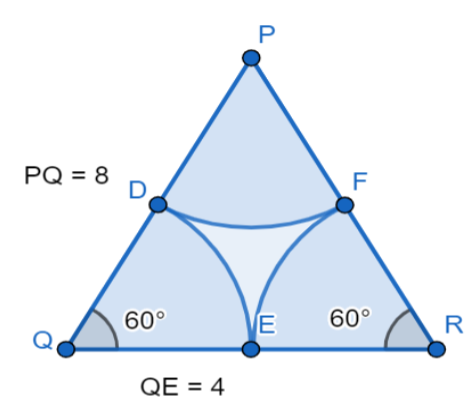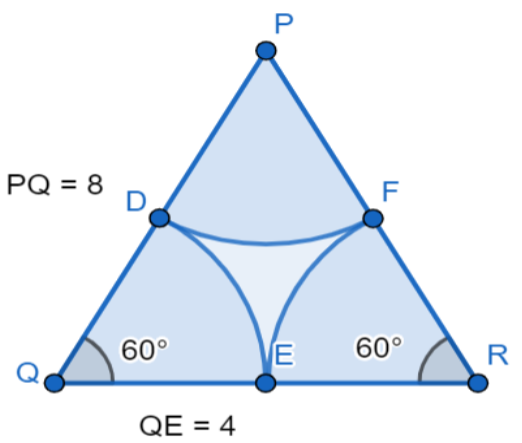
In the given figure, $\Delta PQR$ is an equilateral triangle of side $8$cm and $D$, $E$, $F$ are the centers of the circles of radius $4$ cm. Find the area of the region $DEF$. (Use $\pi =3.14$ and $\sqrt{3}=1.732$)


Answer
558k+ views
Hint: In the given diagram we can observe two geometric shapes: they are one equilateral triangle and three circular arcs or sectors. We need to calculate the area of the shaded part. From the given diagram we can calculate the required area by subtracting the total area of the three sectors or three circular arcs from the total area of the equilateral triangle. We know that the area of the sector making an angle of $\theta $ and having radius $r$ is given by $A=\dfrac{\theta }{360{}^\circ }\times \pi {{r}^{2}}$ and we know that the area of an equilateral triangle having side length is $A=\dfrac{\sqrt{3}}{4}{{a}^{2}}$.
Complete step-by-step solution
Given that,
$\Delta PQR$ is an equilateral triangle of side $8$cm as shown in figure

Area of the triangle is given by
$\begin{align}
& {{A}_{1}}=\dfrac{\sqrt{3}}{4}\times {{8}^{2}} \\
& \Rightarrow {{A}_{1}}=\dfrac{\sqrt{3}}{4}\times 64 \\
\end{align}$
Dividing the $64$ with $4$ then we will get
${{A}_{1}}=\sqrt{3}\times 16$
Given that $\sqrt{3}=1.732$, then the area of the triangle is
$\begin{align}
& {{A}_{1}}=1.732\times 16 \\
& \Rightarrow {{A}_{1}}=27.712c{{m}^{2}} \\
\end{align}$
In the diagram we have three sectors of radius $4$ cm and making an angle of $60{}^\circ $. Now the area of the sector is given by
$\begin{align}
& {{A}_{2}}=\dfrac{60{}^\circ }{360{}^\circ }\times \pi \times {{4}^{2}} \\
& \Rightarrow {{A}_{2}}=\dfrac{1}{6}\times \pi \times 16 \\
\end{align}$
Given that $\pi =3.14$ then the area of the sector is
$\begin{align}
& {{A}_{2}}=\dfrac{1}{6}\times 3.14\times 16 \\
& \Rightarrow {{A}_{2}}=8.373c{{m}^{2}} \\
\end{align}$
Now the total area of the three sectors can be calculated by multiplying the area of one sector with $3$.
$\begin{align}
& \therefore 3{{A}_{2}}=3\times 8.373 \\
& \Rightarrow 3{{A}_{2}}=25.12c{{m}^{2}} \\
\end{align}$
From the given diagram area of the shaded part can be calculated by subtracting the total area of three sectors from the total area of the triangle. Mathematically,
$\begin{align}
& {{A}_{r}}={{A}_{1}}-3{{A}_{2}} \\
& \Rightarrow {{A}_{r}}=27.712-25.12 \\
& \Rightarrow {{A}_{r}}=2.592c{{m}^{2}} \\
\end{align}$
$\therefore $ The area of the shaded part in the given diagram is $2.592$ sq.cm
Note: We can directly find the required area from the equation${{A}_{r}}={{A}_{1}}-3{{A}_{2}}$ Where ${{A}_{1}}$ is the area of the equilateral triangle and ${{A}_{2}}$ is the area of the circular sector.
$\begin{align}
& \therefore {{A}_{r}}={{A}_{1}}-3{{A}_{2}} \\
& \Rightarrow {{A}_{r}}=\dfrac{\sqrt{3}}{4}\times {{8}^{2}}-3\times \dfrac{60{}^\circ }{360{}^\circ }\times \pi \times {{4}^{2}} \\
& \Rightarrow {{A}_{r}}=\dfrac{\sqrt{3}}{4}\times 64-3\times \dfrac{1}{6}\times \pi \times 16 \\
& \Rightarrow {{A}_{r}}=\sqrt{3}\times 16-8\times \pi \\
& \Rightarrow {{A}_{r}}=1.732\times 16-8\times 3.14 \\
& \Rightarrow {{A}_{r}}=27.712-25.12 \\
& \Rightarrow {{A}_{r}}=2.592c{{m}^{2}} \\
\end{align}$
From both the methods we got the same answer.
Complete step-by-step solution
Given that,
$\Delta PQR$ is an equilateral triangle of side $8$cm as shown in figure

Area of the triangle is given by
$\begin{align}
& {{A}_{1}}=\dfrac{\sqrt{3}}{4}\times {{8}^{2}} \\
& \Rightarrow {{A}_{1}}=\dfrac{\sqrt{3}}{4}\times 64 \\
\end{align}$
Dividing the $64$ with $4$ then we will get
${{A}_{1}}=\sqrt{3}\times 16$
Given that $\sqrt{3}=1.732$, then the area of the triangle is
$\begin{align}
& {{A}_{1}}=1.732\times 16 \\
& \Rightarrow {{A}_{1}}=27.712c{{m}^{2}} \\
\end{align}$
In the diagram we have three sectors of radius $4$ cm and making an angle of $60{}^\circ $. Now the area of the sector is given by
$\begin{align}
& {{A}_{2}}=\dfrac{60{}^\circ }{360{}^\circ }\times \pi \times {{4}^{2}} \\
& \Rightarrow {{A}_{2}}=\dfrac{1}{6}\times \pi \times 16 \\
\end{align}$
Given that $\pi =3.14$ then the area of the sector is
$\begin{align}
& {{A}_{2}}=\dfrac{1}{6}\times 3.14\times 16 \\
& \Rightarrow {{A}_{2}}=8.373c{{m}^{2}} \\
\end{align}$
Now the total area of the three sectors can be calculated by multiplying the area of one sector with $3$.
$\begin{align}
& \therefore 3{{A}_{2}}=3\times 8.373 \\
& \Rightarrow 3{{A}_{2}}=25.12c{{m}^{2}} \\
\end{align}$
From the given diagram area of the shaded part can be calculated by subtracting the total area of three sectors from the total area of the triangle. Mathematically,
$\begin{align}
& {{A}_{r}}={{A}_{1}}-3{{A}_{2}} \\
& \Rightarrow {{A}_{r}}=27.712-25.12 \\
& \Rightarrow {{A}_{r}}=2.592c{{m}^{2}} \\
\end{align}$
$\therefore $ The area of the shaded part in the given diagram is $2.592$ sq.cm
Note: We can directly find the required area from the equation${{A}_{r}}={{A}_{1}}-3{{A}_{2}}$ Where ${{A}_{1}}$ is the area of the equilateral triangle and ${{A}_{2}}$ is the area of the circular sector.
$\begin{align}
& \therefore {{A}_{r}}={{A}_{1}}-3{{A}_{2}} \\
& \Rightarrow {{A}_{r}}=\dfrac{\sqrt{3}}{4}\times {{8}^{2}}-3\times \dfrac{60{}^\circ }{360{}^\circ }\times \pi \times {{4}^{2}} \\
& \Rightarrow {{A}_{r}}=\dfrac{\sqrt{3}}{4}\times 64-3\times \dfrac{1}{6}\times \pi \times 16 \\
& \Rightarrow {{A}_{r}}=\sqrt{3}\times 16-8\times \pi \\
& \Rightarrow {{A}_{r}}=1.732\times 16-8\times 3.14 \\
& \Rightarrow {{A}_{r}}=27.712-25.12 \\
& \Rightarrow {{A}_{r}}=2.592c{{m}^{2}} \\
\end{align}$
From both the methods we got the same answer.
Recently Updated Pages
Master Class 10 General Knowledge: Engaging Questions & Answers for Success

Master Class 10 Computer Science: Engaging Questions & Answers for Success

Master Class 10 English: Engaging Questions & Answers for Success

Master Class 10 Social Science: Engaging Questions & Answers for Success

Master Class 10 Maths: Engaging Questions & Answers for Success

Master Class 10 Science: Engaging Questions & Answers for Success

Trending doubts
The shortest day of the year in India

Why is there a time difference of about 5 hours between class 10 social science CBSE

Write a letter to the principal requesting him to grant class 10 english CBSE

What is the median of the first 10 natural numbers class 10 maths CBSE

The Equation xxx + 2 is Satisfied when x is Equal to Class 10 Maths

Which of the following does not have a fundamental class 10 physics CBSE




